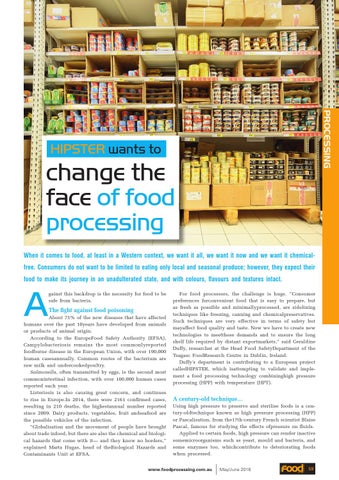PROCESSING
HIPSTER wants to
change the face of food processing When it comes to food, at least in a Western context, we want it all, we want it now and we want it chemicalfree. Consumers do not want to be limited to eating only local and seasonal produce; however, they expect their food to make its journey in an unadulterated state, and with colours, flavours and textures intact.
A
gainst this backdrop is the necessity for food to be safe from bacteria.
The fight against food poisoning
About 75% of the new diseases that have affected humans over the past 10years have developed from animals or products of animal origin. According to the EuropeFood Safety Authority (EFSA), Campylobacteriosis remains the most commonlyreported foodborne disease in the European Union, with over 190,000 human casesannually. Common routes of the bacterium are raw milk and undercookedpoultry. Salmonella, often transmitted by eggs, is the second most commonintestinal infection, with over 100,000 human cases reported each year. Listeriosis is also causing great concern, and continues to rise in Europe.In 2014, there were 2161 confirmed cases, resulting in 210 deaths, the highestannual number reported since 2009. Dairy products, vegetables, fruit andseafood are the possible vehicles of the infection. “Globalisation and the movement of people have brought about trade infood, but there are also the chemical and biological hazards that come with it— and they know no borders,” explained Marta Hugas, head of theBiological Hazards and Contaminants Unit at EFSA.
For food processors, the challenge is huge. “Consumer preferences forconvenient food that is easy to prepare, but as fresh as possible and minimallyprocessed, are sidelining techniques like freezing, canning and chemicalpreservatives. Such techniques are very effective in terms of safety but mayaffect food quality and taste. Now we have to create new technologies to meetthese demands and to ensure the long shelf life required by distant exportmarkets,” said Geraldine Duffy, researcher at the Head Food SafetyDepartment of the Teagasc FoodResearch Centre in Dublin, Ireland. Duffy’s department is contributing to a European project calledHIPSTER, which isattempting to validate and implement a food processing technology combininghigh pressure processing (HPP) with temperature (HPT).
A century-old technique… Using high pressure to preserve and sterilise foods is a century-oldtechnique known as high pressure processing (HPP) or Pascalisation, from the17th-century French scientist Blaise Pascal, famous for studying the effects ofpressure on fluids. Applied to certain foods, high pressure can render inactive somemicroorganisms such as yeast, mould and bacteria, and some enzymes too, whichcontribute to deteriorating foods when processed.
www.foodprocessing.com.au
May/June 2016
59
